Water-hungry lawns are symbols of Los Angeles’ past. In this series, we spotlight yards with alternative, low-water landscaping built for the future.
When it’s hot in Los Angeles, hummingbirds, butterflies and bees flock to the gardens that Lexie Glass and her husband, Evan Hursley, have been building in Harvard Park for the past three years.
“Their garden is a good example of how your landscape can be a universe for wildlife,” says Katie Tilford, development director at Theodore Payne Foundation for Wild Flowers and Native Plants, which has featured Glass and Hursley’s garden on its annual Native Plant Garden Tour.
For Glass, the gardens are not just “their space,” but an environment to be shared with the natural world. “The [COVID-19] pandemic really stressed the importance we hold for the landscape around Southern California,” says Glass, who is originally from Arkansas, “so creating our own around our house was an exciting opportunity.”
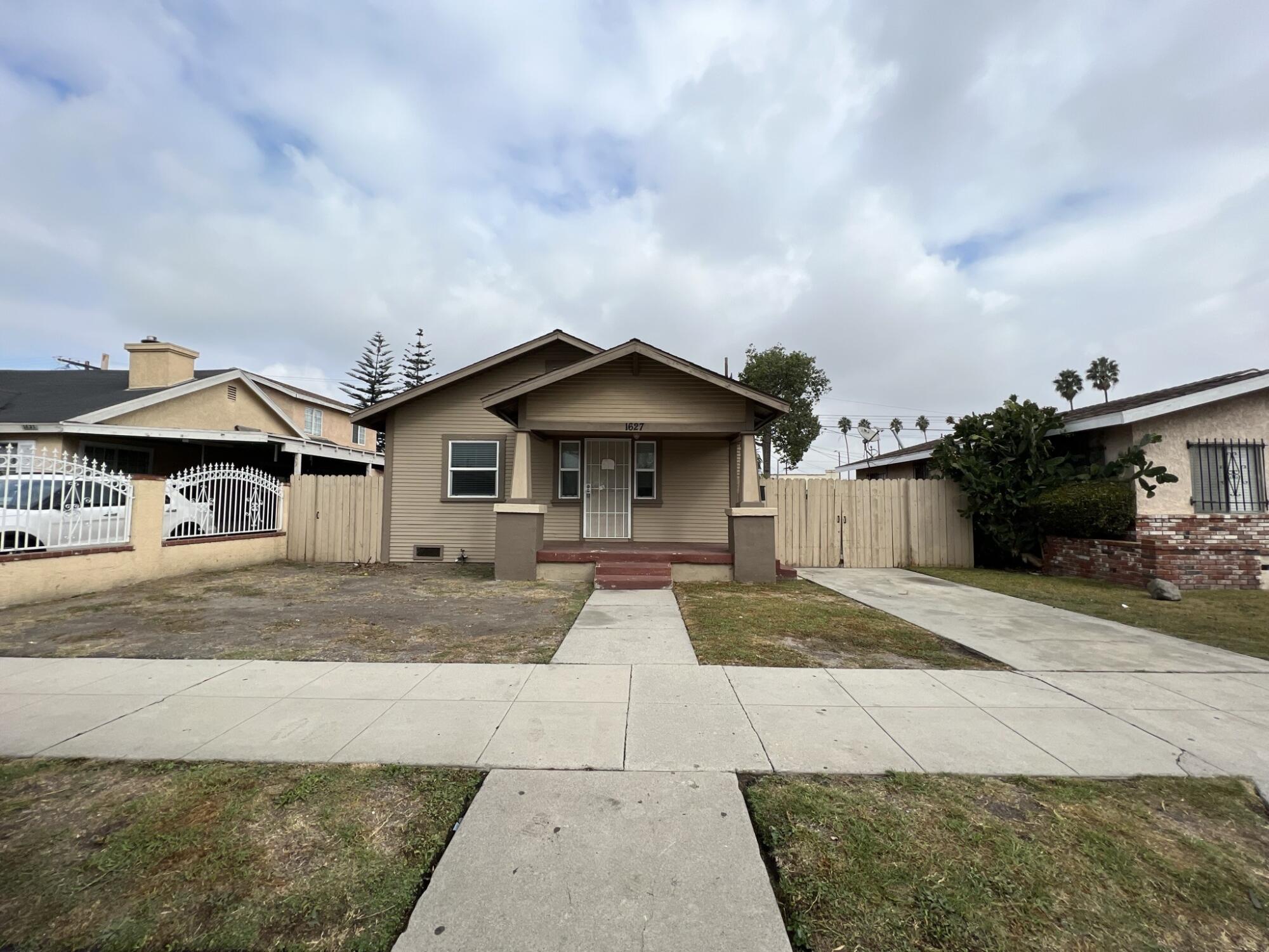
The home of Lexie Glass and Evan Hursley in 2022 before they repainted the house green, tore out their lawn and planted a native landscape.
(Lexie Glass)
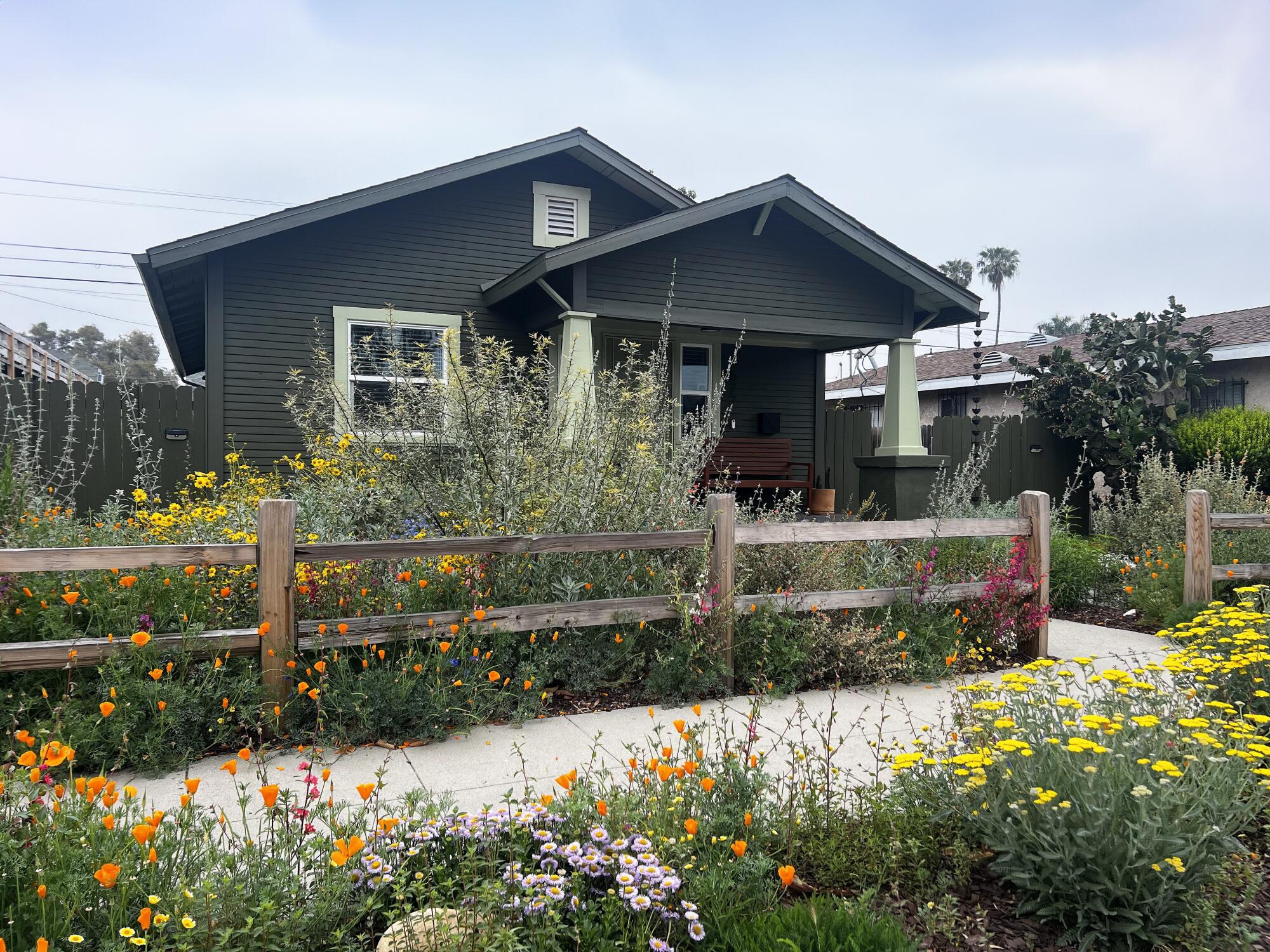
Their home and garden a year later.
(Lexie Glass)
When the couple purchased the 900-square-foot Craftsman in late 2021, their front and back lawn were primarily brown and dead, and concrete was prevalent.
A creative couple — Glass is a designer and Hursley is an architect — the 31-year-olds were accustomed to creating plans and managing projects.
So when they learned that the Los Angeles Department of Water and Power’s turf replacement program would pay them to convert their grass into a low-water landscape with California-friendly plants, they were excited to spearhead a DIY project for themselves and use the rebate to cover their expenses.
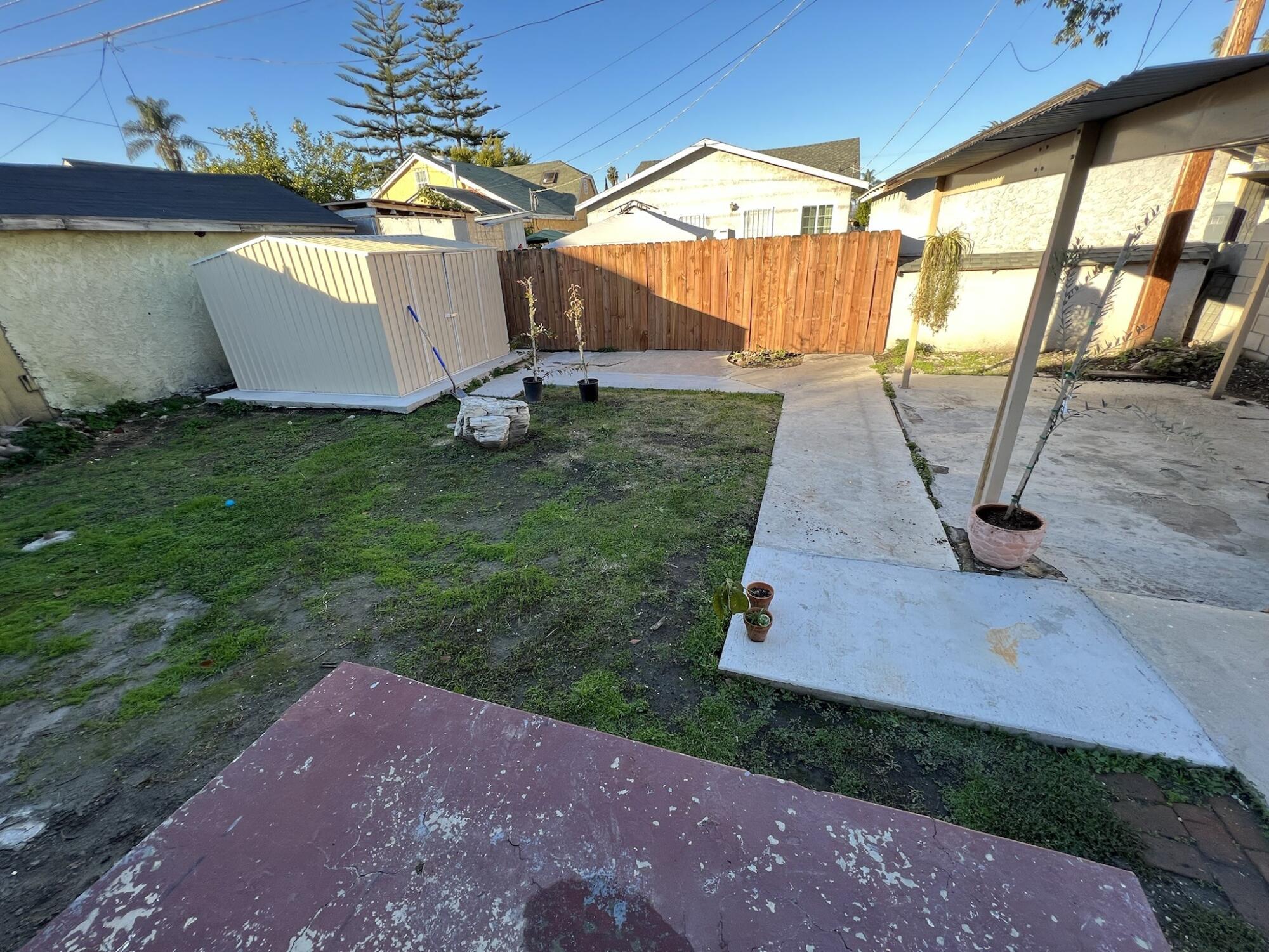
Their backyard before they removed the lawn and broke up the concrete path with sledgehammers.
(Lexie Glass)
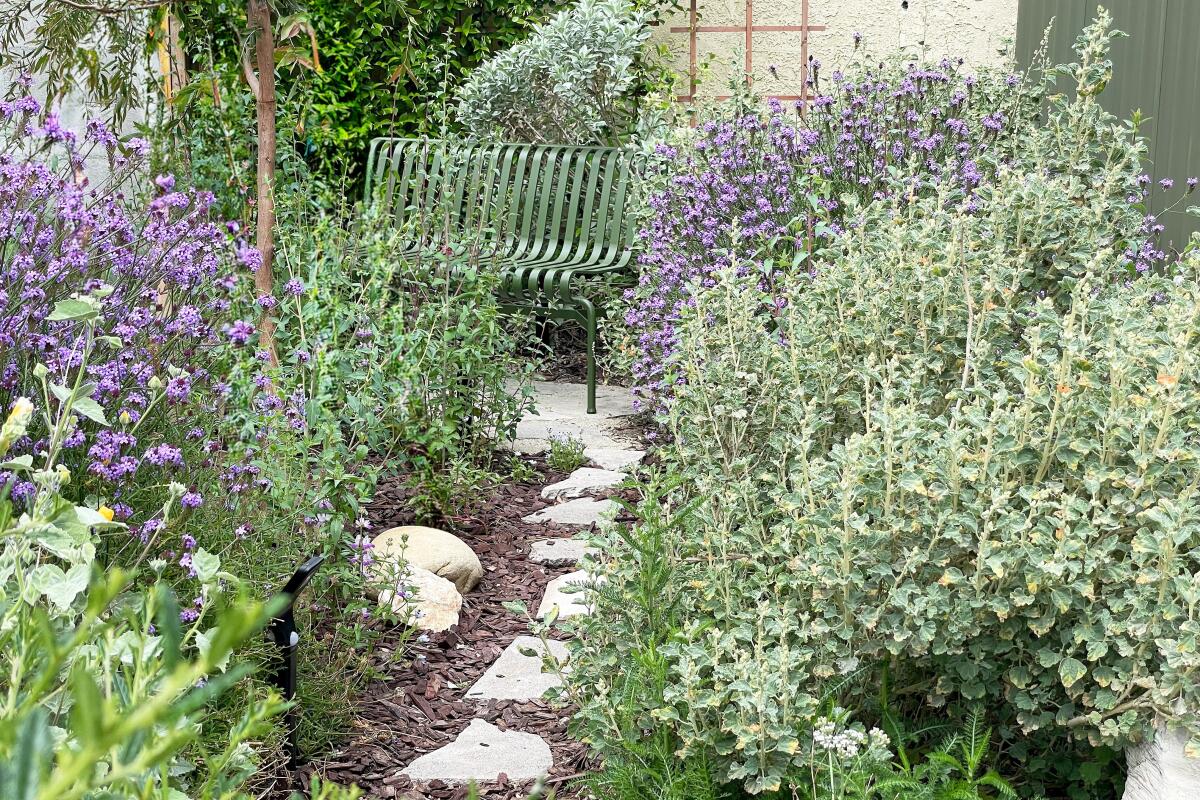
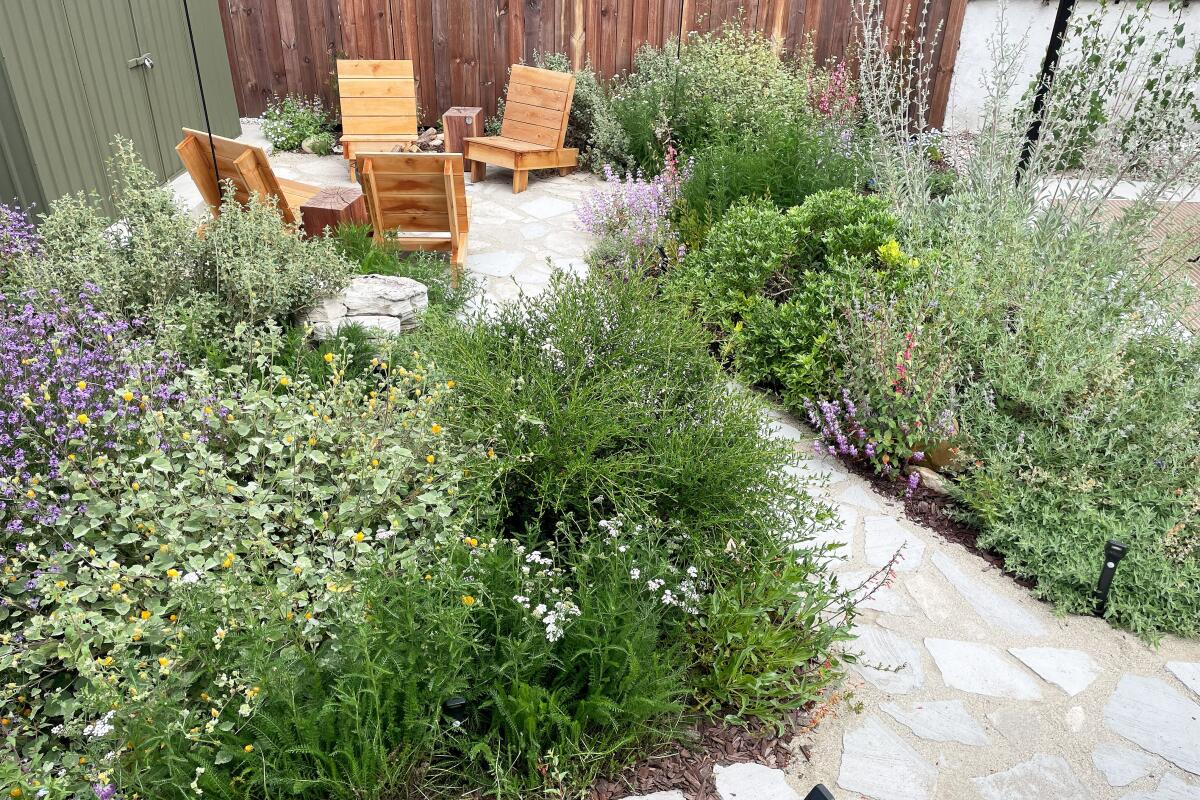
The backyard a year later. (Lexie Glass)
Soon after the two bought the property, they started their yard project by removing the L-shaped strip of concrete in the backyard with a sledgehammer. Next, they dug a pathway through the back and side yards, installing the broken pieces of concrete to form “sinuous paths that would lead to moments of discovery,” Glass says.
After laying the groundwork for their paths, the couple removed a gnarled fig tree stump and covered the grass and weeds with leftover cardboard boxes from their move. This process, known as sheet mulching, involves layering cardboard or newspaper over the grass and weeds to smother them, creating a natural compost that enriches the soil and suppresses weed growth.
Despite their initial lack of gardening knowledge, Glass and Hursley caught on quickly by watching YouTube videos on how to plant a native garden in Los Angeles by filmmaker Loren Johnson, who had torn out his lawn. They also attended online lectures on the Waterwise Community Center and California Native Plant Society channels. Similarly, they taught themselves how to install drip irrigation, select native plants and design their garden using resources such as the Waterwise Garden Planner and Calscape websites.
“Evan and I spent many Saturday mornings, eating breakfast and watching the native garden design lectures during our planning phase,” Glass says.
Given the compact size of their bungalow, the couple saw their garden as more than just a wildlife habitat. It was an extension of their home. In the backyard, where they planned to spend most of their time, they included a lounge area next to a fire pit, complete with Adirondack-style chairs they built with redwood. They also added an outdoor dining area, a birdbath and an alcove with a bench, all situated in the shade of fragrant natives.
The backyard is anchored around an open-air pavilion that serves as a dining room, which was created from existing four steel columns and steel beams installed on a concrete pad. To give it a more streamlined look, they removed the corrugated sheet metal roof and added 2-by-8 foot wood members across the beams, painting both the wood and steel black. Next, they attached string lights along the bottom of the wooden members and installed tension cables from the ground to the end members in a zigzag pattern, allowing the five morning glory plants they planted to climb up the wires and over the trellis.
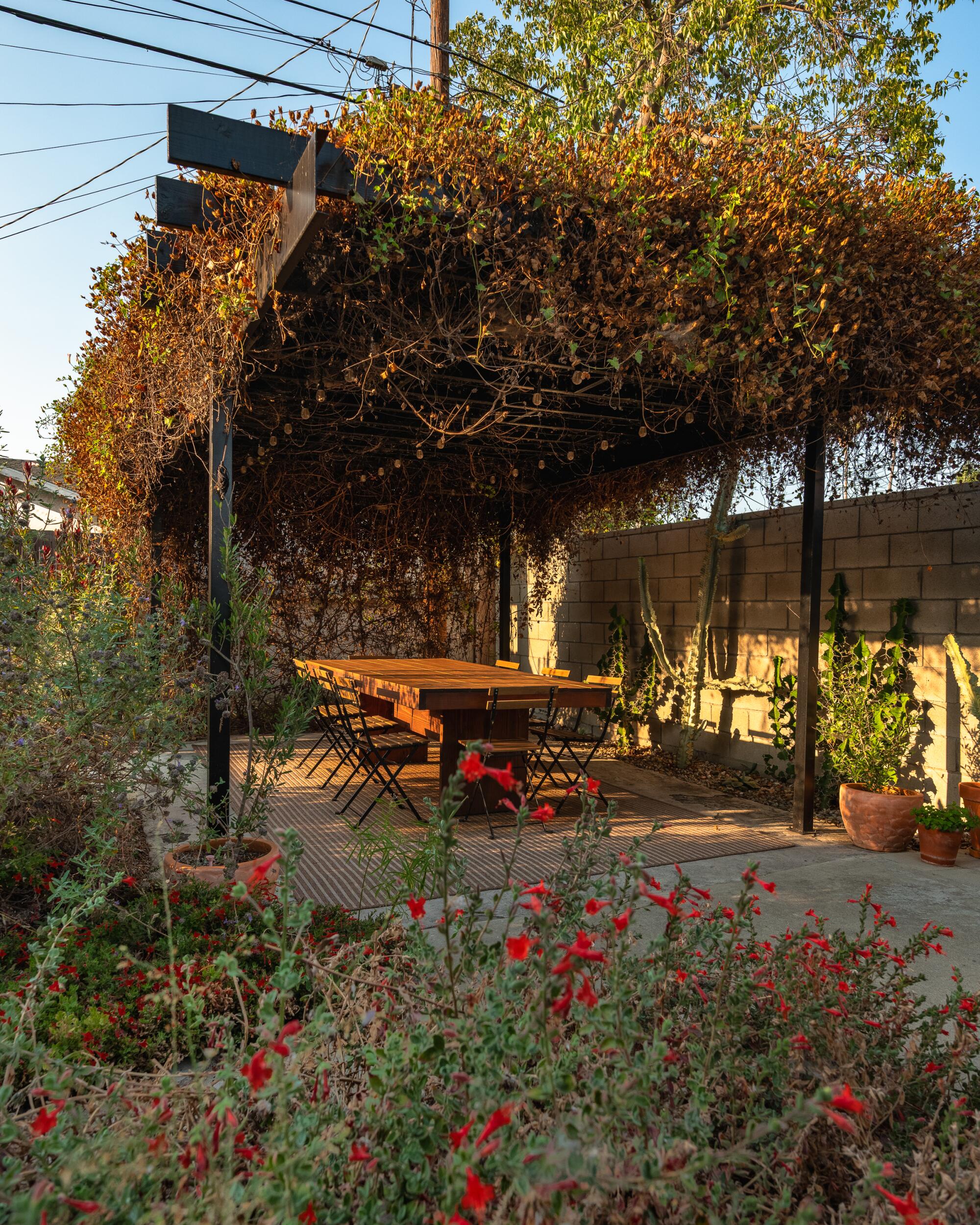
The open air dining room today is shaded by Morning Glory plants.
(Fran Tamse / For The Times)
Working on weekends, the couple installed the pathways and mulched the soil after it had decomposed under the weight of the sheet mulching.
To add rocks to their design, the couple transported them on a stretcher. “That was a lot of work,” Hursley says. They then moved on to planting, sourcing primarily from Theodore Payne, Plant Material and Artemisia native plant nurseries in Los Angeles.
When it came to choosing the plants, the couple aimed to create a dynamic garden by varying the heights and widths of the plants to achieve a visually appealing effect. They strategically placed some of the tall plants to screen unsightly views and create shady moments. “You have to walk around the plants, which helps to create intrigue,” Glass says. “This was a tip we learned while watching the lecture series held by the California Native Plant Society on YouTube.”
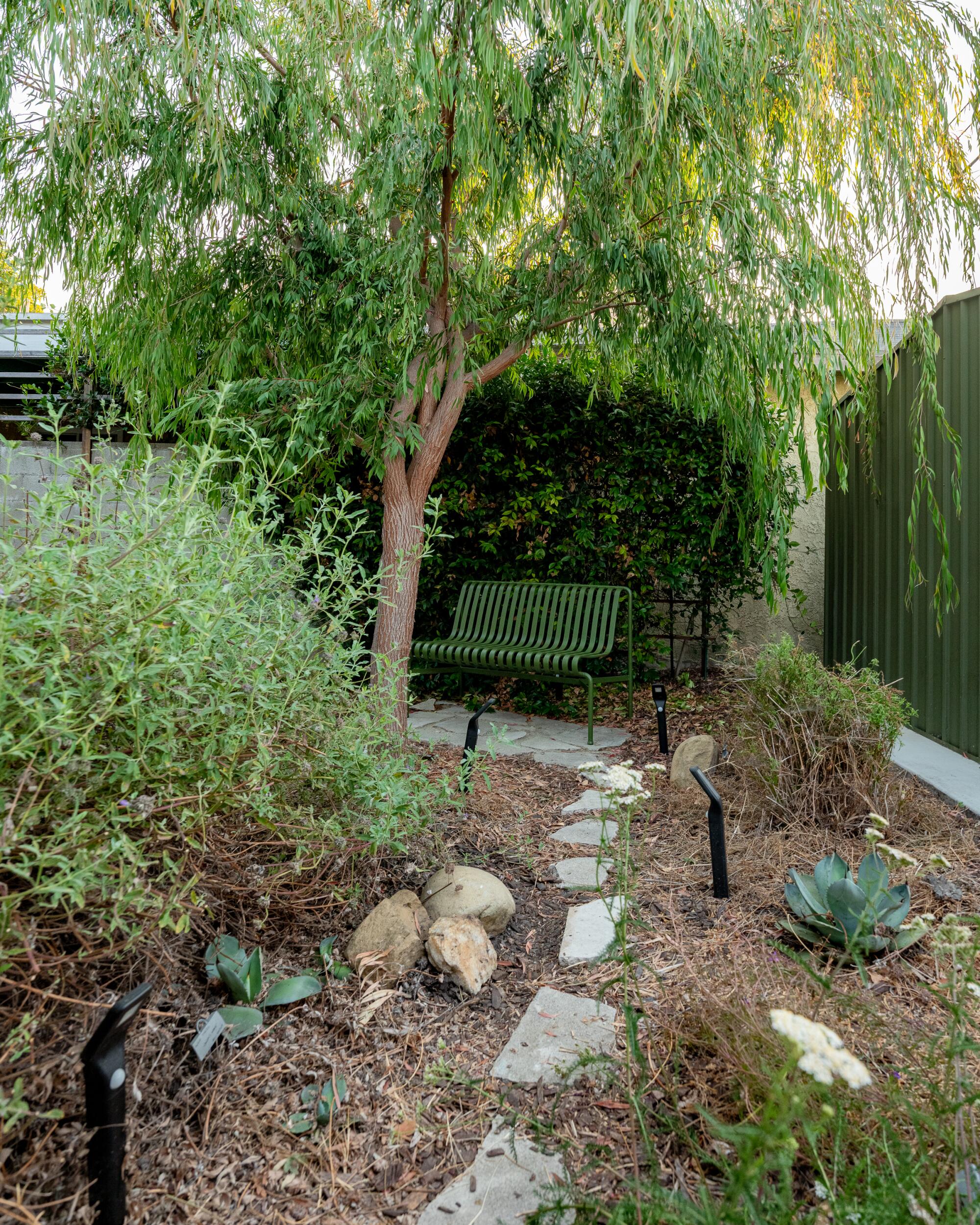
The couple created a series of outdoors rooms in the backyard, including this alcove in the shade of a peppermint tree, Agonis flexuosa.
(Fran Tamse / For The Times)
According to Tilford, the couple chose a plant palette that is easy to maintain and recommended in Theodore Payne’s “Easy Native Plants for Southern California” list, which includes several varieties of sage, apricot mallow, De La Mina lilac verbena and bush sunflower, with California native wildflower seeds filling in the gaps. The couple chose these plants not only for their low-maintenance requirements but also for their leaf textures, flower colors and the timing of when the plants will flower or go dormant.
In the front yard, where they installed a dry creek bed that collects stormwater, the couple was inspired by Cues to Care, landscape architect Joan Nassauer’s theory that visible human care for a landscape can effect change in the neighborhood.
“We added lots of fragrant varieties to the front yard to greet us and our guests home, but also to hopefully spark intrigue with neighbors as they walk by,” Glass says. “We hoped they would enjoy both the site and the smells of native plants and begin to appreciate native plants if they didn’t already.”
Glass and Hursley planted 250 mostly one-gallon plants, 80% of which are native to California, while the others are drought-tolerant plants from countries with similar climates. Three years in, they admit they made mistakes along the way. “Everything grew much larger than the literature we read predicted,” Hursley says. “Coyote mint is taking over our creek bed.” Also, some plants didn’t survive.
Trial and error is to be expected in a garden, Tilford says. “That’s part of the experience. Allowing yourself to fail is a way of permitting yourself to learn something new. That is a valuable lesson: Everything is going to get bigger than you think, especially if it’s next to a path or sidewalk.”
After submitting Glass and Hursley plans to the LADWP’s replacement program, which currently offers a $5-per-square-foot rebate, the $5,100 they received covered all their material expenses. “All we had to supply was the labor,” Glass says.
When nearly 300 tour-goers visited the garden in the spring, they were treated to bright orange California poppies, cobalt-blue ceanothus flowers — a fan favorite, the couple says — yellow bush sunflowers and the bold pink flowers of hummingbird sage.
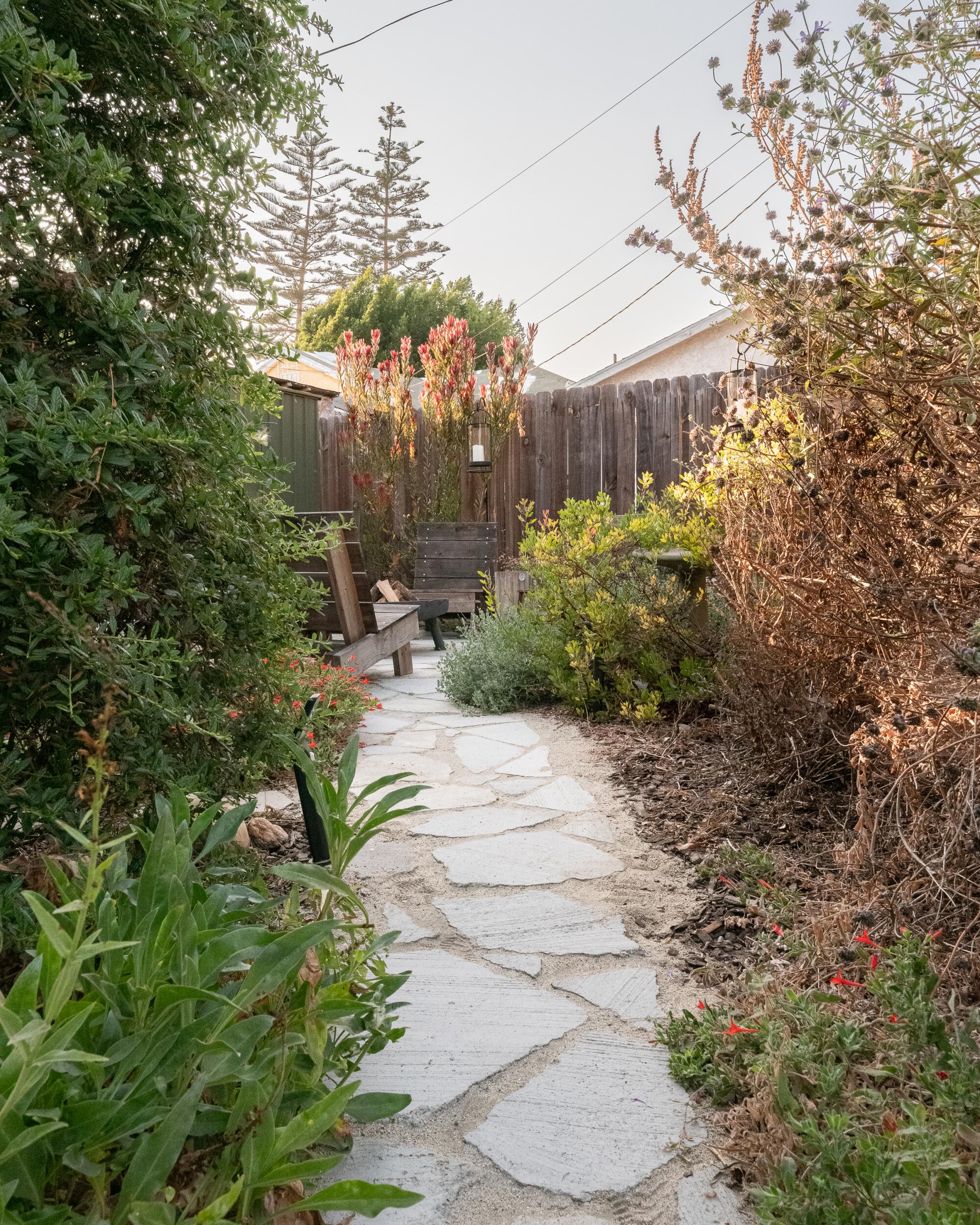
A concrete pathway the couple repurposed and installed themselves is lined with tall plants that offer shade.
Come summer, some plants are dormant, but the wildlife, and in some instances, flowers like De La Mina verbena continue to bloom. Although they added plants to nearly half the property, the couple likes that the garden feels much larger than it did before.
“Our theory is that our brains soak in all these new layers of visual interest and perceive multiple outdoor rooms,” Glass says.
At one point, when the front yard was covered in mulch and the plants were going in, some neighbors questioned the project, saying the grass looked better. But as the plants started coming in and colorful native plants lined the sidewalks, their neighbors were charmed. “It gives you a reason to explore the garden,” Hursley says, smiling. “We can walk around for hours.”
“We hope that everyone can see that you can do it yourself,” adds Glass. “You do not need ample space to create your oasis — just a bit of planning and an appetite for experimentation.”
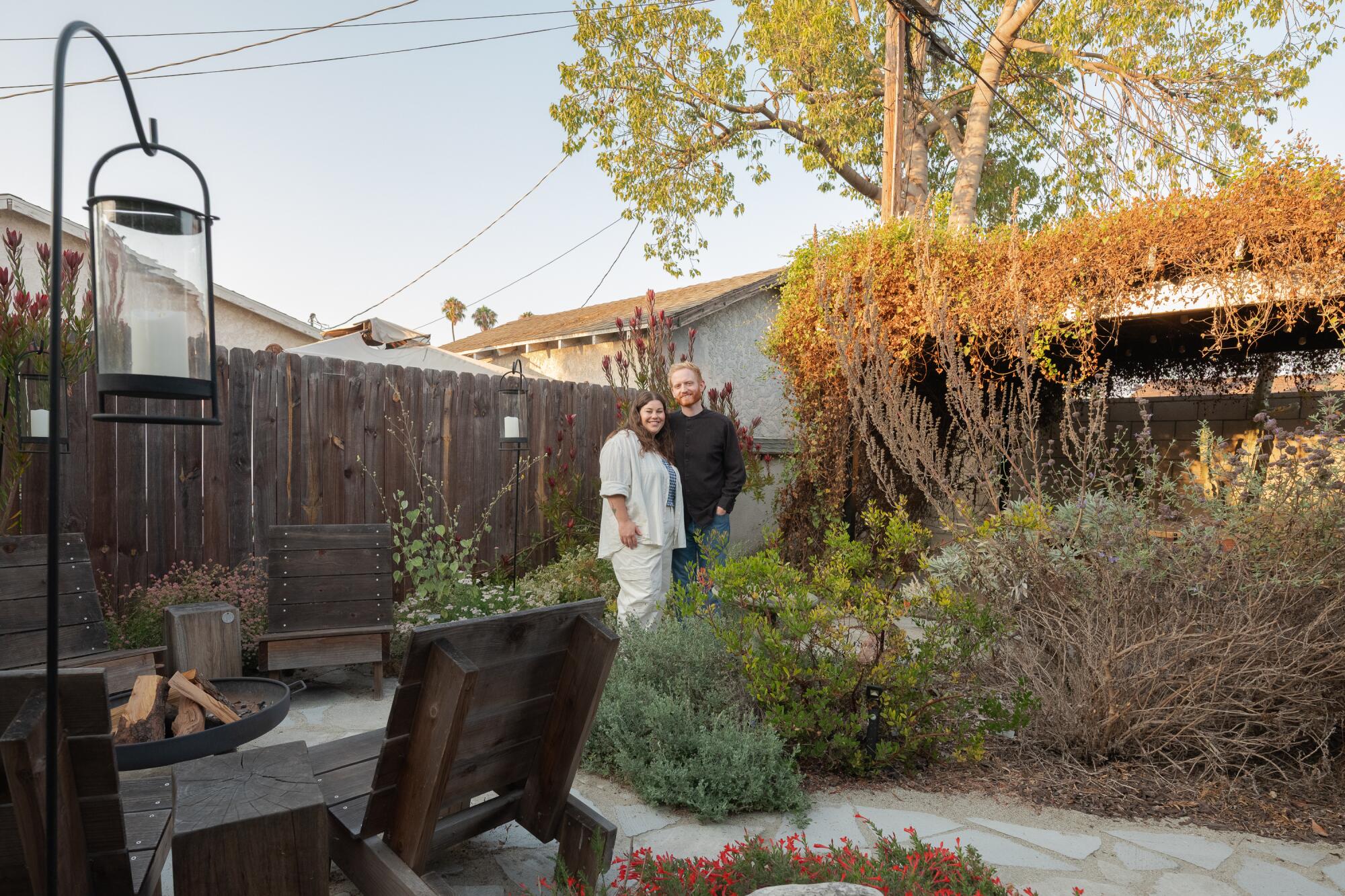
Lexie Glass and Evan Hursley began the process of replacing their front and back lawns with native plants in January 2022.
Plant list
Peppermint Tree, Agonis flexuosa
Desert Museum Palo Verde, Cercidium ‘Desert Museum’
‘Eureka’ Semi Dwarf Lemon, Citrus X Limon ‘Eureka’
Washington Navel Dwarf Orange, Citrus Sinensis, Washington
Dwarf Bartlett Pear, Pyrus Communis
Morning Glory, Calystegia purpurata
Howard McMinn Manzanita, Arctostaphylos ‘Howard McMinn’
Concha Ceanothus, Ceanothus ‘Concha’
Firecracker Penstemon, Penstemon Eatonii
Desert Spoon, Dasylirion Wheeleri ‘Desert Spoon’
California Buckwheat, Eriogonum fasciculatum
Scarlet Columbine, Aquilegia formosa
Moonshine Yarrow, Achillea ‘Moonshine’
Desert globemallow, Sphaeralcea ambigua
Coyote Mint, Monardella Villosa
Parry’s Agave, Agave Parryi
California Fuchsia, Epilobium canum
Star Jasmine, Jasminum multiflorum
Narrow Leaf Milkweed, Asclepias fascicularis
Margarita BOP Penstemon, Penstemon heterophyllus ‘Margarita BOP’
White Sage, Salvia Apiana
De La Mina Verbena, Verbena lilacina ‘De La Mina’
Bush Sunflower, Encelia californica
Common Yarrow, Achillea millefolium
Everett’s Choice California Fuchsia, Epilobium canum ‘Everett’s Choice’
Hummingbird Sage, Salvia Spathacea
California Poppy, Eschscholzia Californica
Brittlebush, Encelia farinosa
Allen Chickering Sage, Salvia ‘Allen Chickering’
Palmer’s Indian Mallow, Abutilon palmeri
Elegant Clarkia, Clarkia unguiculata
Bird’s Eyes, Gilia tricolor
Iris Pacific Coast Hybrids
Wendy Alumroot, Heuchera ‘Wendy’
Coral Bells, Heuchera
Yerba Buena, Clinopodium douglasii
Seaside Daisy, Erigeron glaucus
Catalina Currant, Ribes viburnifolium
Safari Sunset Conebush, Leucadendron ‘Safari Sunset’
San Miguel Island Buckwheat and Red Buckwheat, Eriogonum grande var. rubescens
Germander Sage, Salvia chamaedryoides
Cow’s Horn Cactus, Euphorbia grandicornis
Variegated African Candelabra, Euphorbia ammak variegata
Blue Flax, Linum lewisii
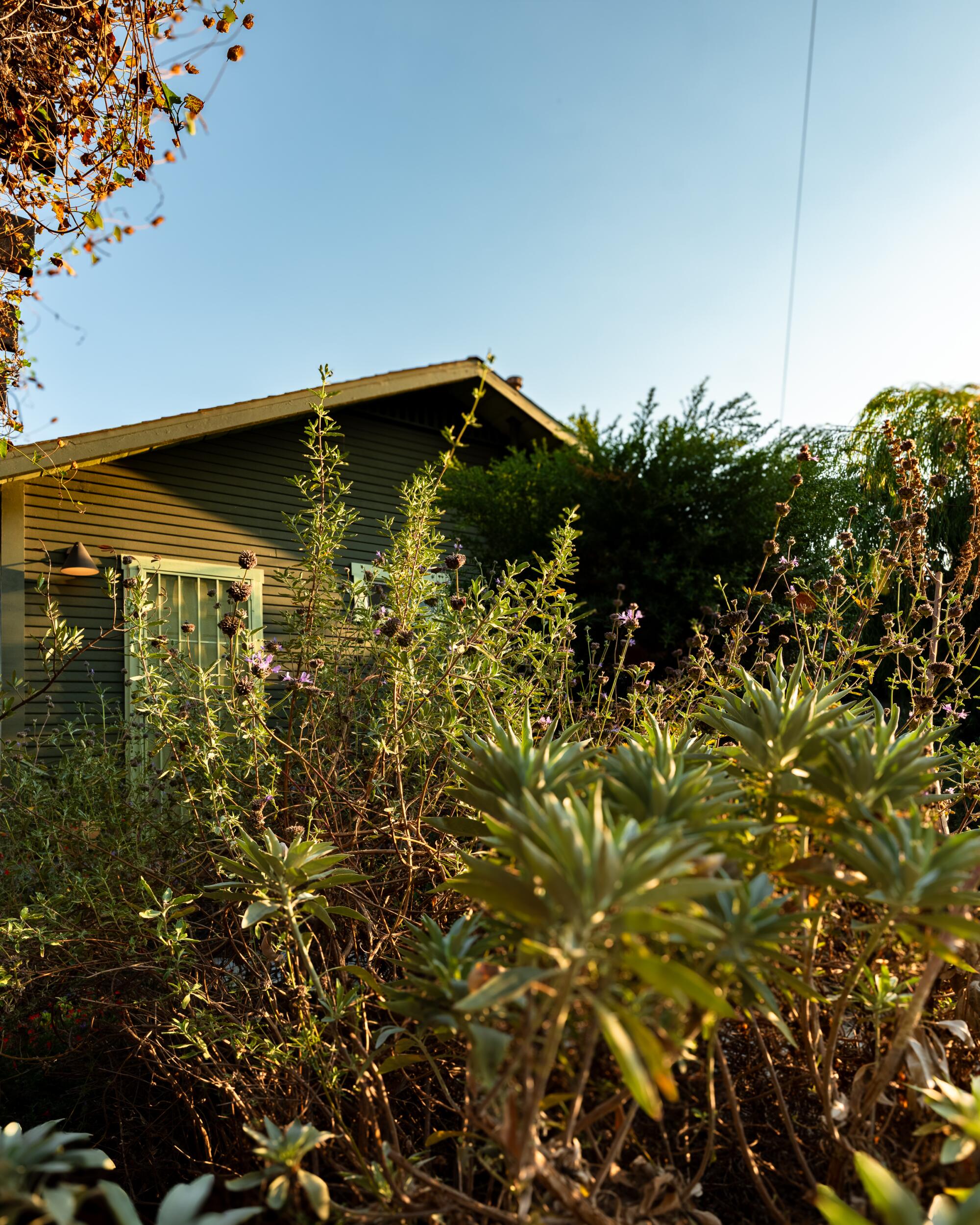
Resources
Turf Replacement Rebate Program
Planting a Native Garden in Los Angeles
California Friendly and Native Landscape Training
California Native Plant Society
Theodore Payne Foundation for Wildflowers and Native Plants



